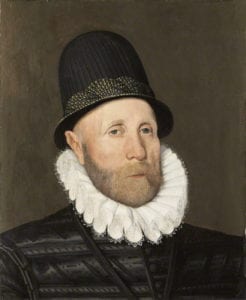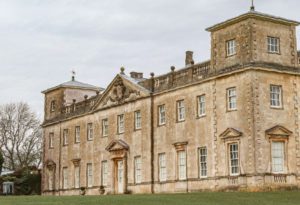St John of Bletso Table Carpet
This month’s Living History piece is about table carpets and in particular the St John of Bletso table carpet that is now in the V&A Museum. Here is an excerpt from the article about it that featured in the Friends’ Report Number 14 from 1981 by Frank T. Smallwood, M.A., F.S.A.
“In Room 53 the Department of Textiles and Dress of the Victoria and Albert Museum, South Kensington, exhibits a very notable example of English Domestic Embroidery bought in 1930 from Lord St.John of Bletso. Primarily the exhibit illustrates the highly skilled needlework of the household furnishings of a noble family in the reign of Queen Elizabeth I, but the border of the carpet has a series of twenty small shields of arms, and in a central roundel there is an achievement of twelve quarterings for a St.John and twelve more for his wife.
The carpet, which is now glazed and framed, consists of a central main panel with two long and two short pieces of border about 1 ft. wide. It is 13*9″ high and 6 ‘ 9″ wide. The over-all colour of the central panel is a bluish green, but wool of seven colours and silk of five colours are used, and there is a little tarnished gold and silver thread. The carpet is worked on linen canvas, mainly in tent stitch with some cross stitch, and the stitches are extremely fine – about 600 stitches per square inch – but the work is not very even. The central panel has a pattern of coiling stems, interlaced and linked by clasps, and bearing leaves, grapes, pomegranates, acorns, carnations, roses, honeysuckle, and borage. Various living creatures occur, including the St.John falcon, and on some of the clasps that link the stems are random letters or groups of letters, e.g. GOD and OSES, most of which have not been accurately interpreted. The general pattern of the design can best be appreciated if viewed from one of the long sides of the carpet. The border also has a pattern of coiling stems interlaced but not linked by clasps, and its twenty small shields of arms record – or were intended ultimately to record – marriages of four generations of the St.Johns of Bletso. Above every shield is a label bearing the surnames of husband and in most cases, wife. The series is to be read clockwise from the top left corner.”
These heraldic details help to date the carpet to 1580 and suggest that it was made for Oliver St John, 1st Lord St John of Bletsoe, 1522 – 1582, who served in the household of Prince Edward, son of Henry VIII, and who on Edward’s accession in 1547 entered the royal household. When the carpet was made, Bletsoe was the residence of the head of the Bedfordshire . St.Johns. About half a century later the 4th Baron purchased Melchbourne, built a mansion, and made it his residence. The carpet remained there for about three centuries.
Table carpets were heavy woollen textiles that were elaborately decorated with brightly-coloured geometric patterns or narrative scene. They were expensive and high-status objects which was why they were used as tablecloths rather than floor coverings.
The first record of one in an inventory comes from the wardrobe of Katherine of Aragon. An example from Bess of Hardwick’s inventory of furnishings at Hardwick Hall in Derbyshire in 1601 lists ‘a fayre long carpet of silk needlework with gold frenge [fringe] lined with crimson taffetie sarcenet…’. Sadly we don’t have a colour print of the St John table carpet but this one from Kinghorn in Fife gives a good impression of what it would have looked like.

